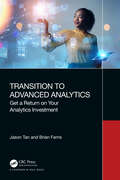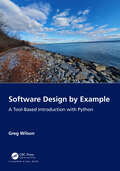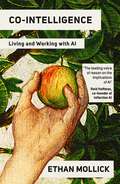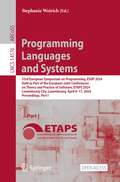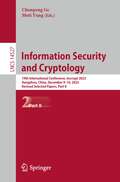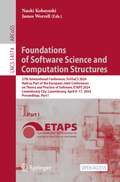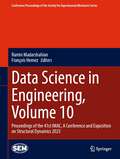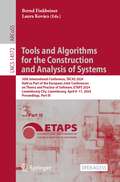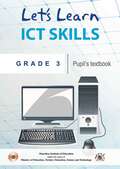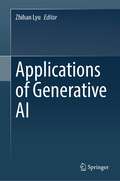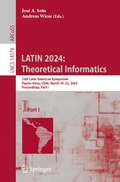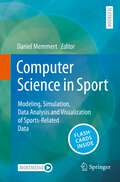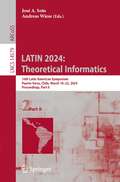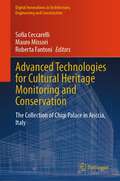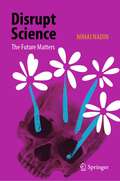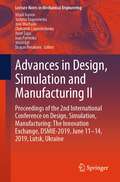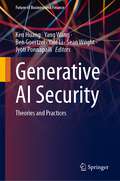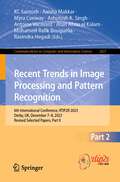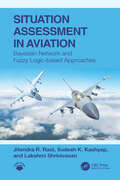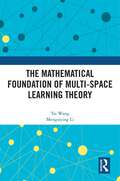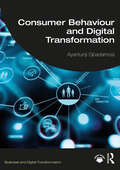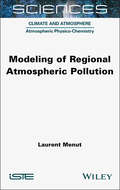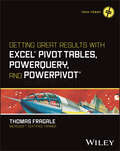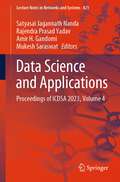- Table View
- List View
Transition to Advanced Analytics: Get a Return on Your Analytics Investment
by Jason Tan Brian FerrisAmazon knows the products we’re interested in and shows us more to boost the size of our shopping cart. Google Maps knows the best route to get from A to B and recommends it to get us there in the shortest possible time. Netflix knows the media we enjoy most and recommends more to boost streaming time. However, many companies still fall short with their data analytics practices.This book focuses on how to embed advanced analytics directly into daily business operations and complement an enterprise system. This book can guide you in how traditional industries like retailers, banks and insurers can utilise and develop advanced analytics complementing their enterprise systems while embedding advanced analytics directly to optimise revenue and customer experience. Detailed in this book is a world-class analytics application used by loyalty point providers, banks, insurers and leading retailers.The title also provides a step-by-step implementation framework for Chief Digital and Artificial Intelligence Offices to develop their advanced analytics capabilities in tandem with legacy IT systems.
Software Design by Example: A Tool-Based Introduction with Python
by Greg WilsonThe best way to learn design in any field is to study examples, and some of the best examples of software design come from the tools programmers use in their own work. Software Design by Example: A Tool-Based Introduction with Python therefore builds small versions of the things programmers use in order to demystify them and give some insights into how experienced programmers think. From a file backup system and a testing framework to a regular expression matcher, a browser layout engine, and a very small compiler, we explore common design patterns, show how making code easier to test also makes it easier to reuse, and help readers understand how debuggers, profilers, package managers, and version control systems work so that they can use them more effectively.This material can be used for self-paced study, in an undergraduate course on software design, or as the core of an intensive weeklong workshop for working programmers. Each chapter has a set of exercises ranging in size and difficulty from half a dozen lines to a full day’s work. Readers should be familiar with the basics of modern Python, but the more advanced features of the language are explained and illustrated as they are introduced.All the written material in this project can be freely reused under the terms of the Creative Commons - Attribution license, while all of the software is made available under the terms of the Hippocratic License. All proceeds from sale of this book will go to support the Red Door Family Shelter in Toronto.Features:• Teaches software design by showing programmers how to build the tools they useevery day• Each chapter includes exercises to help readers check and deepen their understanding• All the example code can be downloaded, re-used, and modified under an open license
Software Design by Example: A Tool-Based Introduction with Python
by Greg WilsonThe best way to learn design in any field is to study examples, and some of the best examples of software design come from the tools programmers use in their own work. Software Design by Example: A Tool-Based Introduction with Python therefore builds small versions of the things programmers use in order to demystify them and give some insights into how experienced programmers think. From a file backup system and a testing framework to a regular expression matcher, a browser layout engine, and a very small compiler, we explore common design patterns, show how making code easier to test also makes it easier to reuse, and help readers understand how debuggers, profilers, package managers, and version control systems work so that they can use them more effectively.This material can be used for self-paced study, in an undergraduate course on software design, or as the core of an intensive weeklong workshop for working programmers. Each chapter has a set of exercises ranging in size and difficulty from half a dozen lines to a full day’s work. Readers should be familiar with the basics of modern Python, but the more advanced features of the language are explained and illustrated as they are introduced.All the written material in this project can be freely reused under the terms of the Creative Commons - Attribution license, while all of the software is made available under the terms of the Hippocratic License. All proceeds from sale of this book will go to support the Red Door Family Shelter in Toronto.Features:• Teaches software design by showing programmers how to build the tools they useevery day• Each chapter includes exercises to help readers check and deepen their understanding• All the example code can be downloaded, re-used, and modified under an open license
Co-Intelligence: Living and Working with AI
by Ethan Mollick'Co-Intelligence is the very best book I know about the ins, outs, and ethics of generative AI. Drop everything and read it cover to cover NOW' Angela DuckworthConsumer AI has arrived. And with it, inescapable upheaval as we grapple with what it means for our jobs, lives and the future of humanity. Cutting through the noise of AI evangelists and AI doom-mongers, Wharton professor Ethan Mollick has become one of the most prominent and provocative explainers of AI, focusing on the practical aspects of how these new tools for thought can transform our world. In Co-Intelligence, he urges us to engage with AI as co-worker, co-teacher and coach. Wide ranging, hugely thought-provoking and optimistic, Co-Intelligence reveals the promise and power of this new era.
Programming Languages and Systems: 33rd European Symposium on Programming, ESOP 2024, Held as Part of the European Joint Conferences on Theory and Practice of Software, ETAPS 2024, Luxembourg City, Luxembourg, April 6–11, 2024, Proceedings, Part I (Lecture Notes in Computer Science #14576)
by Stephanie WeirichThe two-volume open access book set LNCS 14576 + 14577 constitutes the proceedings of the 33rd European Symposium on Programming, ESOP 2024, which was held during April 6-11, 2024, in Luxemburg, as part of the European Joint Conferences on Theory and Practice of Software, ETAPS 2024.The 25 full papers and 1 fresh perspective paper presented in these proceedings were carefully reviewed and selected from 72 submissions. The papers were organized in topical sections as follows:Part I: Effects and modal types; bidirectional typing and session types; dependent types; Part II: Quantum programming and domain-specific languages; verification; program analysis; abstract interpretation.
Information Security and Cryptology: 19th International Conference, Inscrypt 2023, Hangzhou, China, December 9–10, 2023, Revised Selected Papers, Part II (Lecture Notes in Computer Science #14527)
by Chunpeng Ge Moti YungThe two-volume set LNCS 14526 and 14527 constitutes the refereed proceedings of the 19th International Conference on Information Security and Cryptology, Inscrypt 2023, held in Hangzhou, China, during December 9–10, 2023.The 38 full papers and 7 short papers presented in these proceedings were carefully reviewed and selected from 152 submissions. The papers have been organized in the following topical sections: Part I: Signature; blockchain; cryptography primitive; public key cryptography; security and privacy; Part II: System security; cryptography engineering; cryptanalysis; short papers, posters.
Foundations of Software Science and Computation Structures: 27th International Conference, FoSSaCS 2024, Held as Part of the European Joint Conferences on Theory and Practice of Software, ETAPS 2024, Luxembourg City, Luxembourg, April 6–11, 2024, Proceedings, Part I (Lecture Notes in Computer Science #14574)
by Naoki Kobayashi James WorrellThe two open access volumes LNCS 14574 and 14575 constitute the proceedings of the 27th International Conference on Foundations of Software Science and Computation Structures, FOSSACS 2024, which took place in Luxembourg in April 2024.The 24 full papers included in this book were carefully reviewed and selected from 79 submissions. They were organized in topical sections as follows: Part I: Infinite games; categorical semantics; automata and synthesis; Part II: Types and programming languages; logic and proofs; infinite-state systems.
Data Science in Engineering, Volume 10: Proceedings of the 41st IMAC, A Conference and Exposition on Structural Dynamics 2023 (Conference Proceedings of the Society for Experimental Mechanics Series)
by Ramin Madarshahian François HemezData Science in Engineering, Volume 10: Proceedings of the 41st IMAC, A Conference and Exposition on Structural Dynamics, 2023, the tenth volume of ten from the Conference brings together contributions to this important area of research and engineering. The collection presents early findings and case studies on fundamental and applied aspects of Data Science in Engineering, including papers on:Novel Data-driven Analysis MethodsDeep Learning Gaussian Process AnalysisReal-time Video-based AnalysisApplications to Nonlinear Dynamics and Damage DetectionHigh-rate Structural Monitoring and Prognostics
Tools and Algorithms for the Construction and Analysis of Systems: 30th International Conference, TACAS 2024, Held as Part of the European Joint Conferences on Theory and Practice of Software, ETAPS 2024, Luxembourg City, Luxembourg, April 6–11, 2024, Proceedings, Part III (Lecture Notes in Computer Science #14572)
by Bernd Finkbeiner Laura KovácsThe open access book 3-volume set LNCS 14570-14573 constitutes the proceedings of the 30th International Conference on Tools and Algorithms for the Construction and Analysis of Systems, TACAS 2024, which was held as part of the European Joint Conferences on Theory and Practice of Software, ETAPS 2024, during April 6-11, 2024, in Luxembourg.The 53 full papers and 16 short SVComp contributions included in these proceedings were carefully reviewed and selected from 159 submissions. They were organized in topical sections as follows:Part I: STA and SMT solving; synthesis; logic and decidability; program analysis and proofs; proof checking; Part II: Model Checking; automata and learning; software verification; probabilistic systems; simulations; Part III: Neural networks; testing and verification; games; concurrency; SV-Comp 2024.
Let's Learn ICT Skills - Pupil's Book class 3 - MIE
by Mauritius Institute of EducationThe Computer Fundamentals module provides a comprehensive introduction to the world of computing, covering essential concepts and practical skills. It begins with an overview of computers and their types, such as desktops, laptops, and tablets, along with the fundamental components comprising them. Learners explore file management techniques, spreadsheet basics, and word processing tasks, including document formatting and clip art insertion. Presentation skills are developed through creating PowerPoint slideshows. Internet usage dos and don'ts, web addresses, webpage access, saving, and printing are explained, while multimedia tasks in MS Paint are covered. Furthermore, the module emphasizes health, safety, and ethical considerations related to computer usage, highlighting potential health issues like neck and back pain, and eye strain. By encompassing both theoretical knowledge and practical skills, the module equips learners with a solid foundation in computer literacy essential for modern-day endeavors.
Applications of Generative AI
by Zhihan LyuThis book provides a comprehensive introduction to Generative AI in terms of basic concepts, core technologies, technical architecture, and application scenarios. Readers gain a deeper understanding of the emerging discipline of Generative AI. This book covers the latest cutting-edge application technologies of Generative AI in various fields. It provides relevant practitioners with ideas to solve problems and deepen their understanding of Generative AI. At the same time, it guides and helps Generative AI and related industries to deepen their understanding of the industry and enhance professional knowledge and skills. Starting from reality, this book lists many cases and analyzes theories in a popular image. The book is useful for AI researchers and specifically for those working with the applications at hand (primarily medical imaging and construction/twinning industry). It covers a variety of cutting-edge technologies in Generative AI, which provides researchers with new research ideas.
LATIN 2024: 16th Latin American Symposium, Puerto Varas, Chile, March 18–22, 2024, Proceedings, Part I (Lecture Notes in Computer Science #14578)
by José A. Soto Andreas WieseThis book constitutes the proceedings of the 16th Latin American Symposium on Theoretical Informatics, LATIN 2042, which took place in Puerto Varas, Chile, in March 2024. The 44 papers presented in this volume were carefully reviewed and selected from 93 submissions. They were organized in topical sections as follows:Part I: Algorithms and Data Structures; Approximation and Online Algorithms; Complexity Theory; Part II: Combinatorics and Graph Theory; Parameterized Algorithms; Automata Theory and Formal Languages; and Game Theory and Fairness.
Computer Science in Sport: Modeling, Simulation, Data Analysis and Visualization of Sports-Related Data
by Daniel MemmertIn recent years, computer science in sport has grown extremely, mainly because more and more new data has become available. Computer science tools in sports, whether used for opponent preparation, competition, or scientific analysis, have become indispensable across various levels of expertise nowadays. A completely new market has emerged through the utilization of these tools in the four major fields of application: clubs and associations, business, science, and the media. This market is progressively gaining importance within university research and educational activities.This textbook aims to live up to the now broad diversity of computer science in sport by having more than 30 authors report from their special field and concisely summarise the latest findings. The book is divided into four main sections: data sets, modelling, simulation and data analysis. In addition to background information on programming languages and visualisation, the textbook is framed by history and an outlook. Students with a connection to sports science are given a comprehensive insight into computer science in sport, supported by a didactically sophisticated concept that makes it easy to convey the learning content. Numerous questions for self-testing underpin the learning effect and ensure optimal exam preparation. For advanced students, the in-depth discussion of time series data mining, artificial neural networks, convolution kernels, transfer learning and random forests offers additional value.
LATIN 2024: 16th Latin American Symposium, Puerto Varas, Chile, March 18–22, 2024, Proceedings, Part II (Lecture Notes in Computer Science #14579)
by José A. Soto Andreas WieseThis book constitutes the proceedings of the 16th Latin American Symposium on Theoretical Informatics, LATIN 2042, which took place in Puerto Varas, Chile, in March 2024. The 44 papers presented in this volume were carefully reviewed and selected from 93 submissions. They were organized in topical sections as follows:Part I: Algorithms and Data Structures; Approximation and Online Algorithms; Complexity Theory; Part II: Combinatorics and Graph Theory; Parameterized Algorithms; Automata Theory and Formal Languages; and Game Theory and Fairness.
Advanced Technologies for Cultural Heritage Monitoring and Conservation: The Collection of Chigi Palace in Ariccia, Italy (Digital Innovations in Architecture, Engineering and Construction)
by Sofia Ceccarelli Mauro Missori Roberta FantoniThis book provides the results of an extensive scientific measurements campaign using advanced technologies and innovative non-invasive approaches carried out for the first time in such large numbers inside one of the most important baroque residences in Italy, the Chigi Palace in Ariccia, near Rome (Italy), with the aims of monitoring, characterizing and documenting several kinds of heritage items with different conservative and artistic issues. The analyses involved several research groups from regional universities (Sapienza, Tor Vergata, Roma 3) and research institutions (ENEA, INFN, CNR) and they were performed within the ADAMO project, which was addressed to technologies of analysis, diagnostics and monitoring for the preservation and restoration of Cultural Heritage. The project was proposed by the Centre of Excellence at the Technological District for Cultural Heritage (DTC) financed by the Lazio Region. At the Chigi Palace, important collections of paintings, documents, statues and wall decorations are preserved, dating back from the 16th up to the 18th centuries. The purpose of this book is twofold: it provides an overview of methodologies and technologies currently available in the field of heritage science, through the presentation of their in situ applications for the study of different artworks and materials; furthermore, it shows how the non-invasive analyses and the integration of diagnostic results are useful and sometimes crucial, for the overall understanding of heritage items, their conservation status, and for their correct conservation. This book is addressed at a large audience with both humanistic and scientific backgrounds, focusing the reader's attention on the information gained from multidisciplinary studies, also allowing a curious look at scientific methodologies applied to an art-historical context.
Disrupt Science: The Future Matters
by Mihai NadinReaction to breakdowns is more expensive, by many orders of magnitude, than prevention. This again became clear during the COVID-19 pandemic and is evinced in the sustainability crisis. The dynamics of living matter transcends deterministic reaction. Embodied in machines, determinism empowered the human being, providing the path to prosperity. However, in conjunction with reductionism, it does away with complexity, in which life is couched. The living is by necessity anticipatory. Awareness of the future means preserving life not in reaction to, but in anticipation of change. Living entities, from the simplest bacteria, to plants and insects, to human beings, are adaptive, goal-oriented, and capable of self-healing. Anticipatory actions are expressed through non-deterministic processes that unfold in concert with reactions. They engage the wholeness of life, including its interactions with the environment. Awareness of consequences, together with memory of the past, informs actions that reflect the creative nature of human beings. Redefining science—and implicitly, medicine—is not a negation of its past, but rather an affirmation of trust in explaining life’s capacity to renew itself. As opposed to increasingly expensive medicine as a practice of repair, to prevent and to heal is to make life sustainable. The moment of truth can no longer be postponed. At stake is the future of humankind and even of life on planet Earth. Reductionist determinism informs the obsession with progress at any cost. Awareness of the fact that the human condition transcends that of the matter in which it is embodied explains, and indeed justifies, the call to Disrupt Science in its current state. The age of the digital machine, in particular of artificial intelligence, is one of opportunities that pale when compared to its inherent risks. The record of breakdowns (including so-called natural disasters), by now global in scale, is part of the empirical premise for the call for completing the Cartesian Revolution. A “Second Revolution in Science” could unleash humanity’s remaking, free of surrendering to want. Science has the opportunity not only to measure everything—life included—and accumulate data and process it for its own sake, but also to realize its meaning. The book cover is designed by Baruch Gorkin, who is celebrated internationally for exquisite typefaces and for books reflecting meaning-driven design.
Advances in Design, Simulation and Manufacturing II: Proceedings of the 2nd International Conference on Design, Simulation, Manufacturing: The Innovation Exchange, DSMIE-2019, June 11-14, 2019, Lutsk, Ukraine (Lecture Notes in Mechanical Engineering)
by Vitalii Ivanov Justyna Trojanowska Jose Machado Oleksandr Liaposhchenko Jozef Zajac Ivan Pavlenko Milan Edl Dragan PerakovicThis book reports on topics at the interface between manufacturing, mechanical and chemical engineering. It gives special emphasis to CAD/CAE systems, information management systems, advanced numerical simulation methods and computational modeling techniques, and their use in product design, industrial process optimization and in the study of the properties of solids, structures, and fluids. Control theory, ICT for engineering education as well as ecological design, and food technologies are also among the topics discussed in the book. Based on the 2nd International Conference on Design, Simulation, Manufacturing: The Innovation Exchange (DSMIE-2019), held on June 11-14, 2019, in Lutsk, Ukraine, the book provides academics and professionals with a timely overview and extensive information on trends and technologies behind current and future developments of Industry 4.0, innovative design and renewable energy generation.
Generative AI Security: Theories and Practices (Future of Business and Finance)
by Ken Huang Yang Wang Ben Goertzel Yale Li Sean Wright Jyoti PonnapalliThis book explores the revolutionary intersection of Generative AI (GenAI) and cybersecurity. It presents a comprehensive guide that intertwines theories and practices, aiming to equip cybersecurity professionals, CISOs, AI researchers, developers, architects and college students with an understanding of GenAI’s profound impacts on cybersecurity. The scope of the book ranges from the foundations of GenAI, including underlying principles, advanced architectures, and cutting-edge research, to specific aspects of GenAI security such as data security, model security, application-level security, and the emerging fields of LLMOps and DevSecOps. It explores AI regulations around the globe, ethical considerations, the threat landscape, and privacy preservation. Further, it assesses the transformative potential of GenAI in reshaping the cybersecurity landscape, the ethical implications of using advanced models, and the innovative strategies required to secure GenAI applications. Lastly, the book presents an in-depth analysis of the security challenges and potential solutions specific to GenAI, and a forward-looking view of how it can redefine cybersecurity practices. By addressing these topics, it provides answers to questions on how to secure GenAI applications, as well as vital support with understanding and navigating the complex and ever-evolving regulatory environments, and how to build a resilient GenAI security program. The book offers actionable insights and hands-on resources for anyone engaged in the rapidly evolving world of GenAI and cybersecurity.
Recent Trends in Image Processing and Pattern Recognition: 6th International Conference, RTIP2R 2023, Derby, UK, December 7–8, 2023, Revised Selected Papers, Part II (Communications in Computer and Information Science #2027)
by Kc Santosh Aaisha Makkar Myra Conway Ashutosh K. Singh Antoine Vacavant Anas Abou el Kalam Mohamed-Rafik Bouguelia Ravindra HegadiThis book constitutes the refereed proceedings of the 6th International Conference on Recent Trends in Image Processing and Pattern Recognition, RTIP2R 2023, held in Derby, UK, during December 2023, in collaboration with the Applied AI Research Lab at the University of South Dakota.The 62 full papers included in this book were carefully reviewed and selected from 216 submissions. The papers are organized in the following topical sections:Volume I:Artificial intelligence and applied machine learning; applied image processing and pattern recognition; and biometrics and applications.Volume II:Healthcare informatics; pattern recognition in blockchain, IOT, cyber plus network security, and cryptography.
Situation Assessment in Aviation: Bayesian Network and Fuzzy Logic-based Approaches
by Jitendra R. Raol Sudesh K. Kashyap Lakshmi ShrinivasanSituation Assessment in Aviation focuses on new aspects of soft computing technologies for the evaluation and assessment of situations in aviation scenarios. It considers technologies emerging from multisensory data fusion (MSDF), Bayesian networks (BN), and fuzzy logic (FL) to assist pilots in their decision-making.Studying MSDF, BN, and FL from the perspective of their applications to the problem of situation assessment, the book discusses the development of certain soft technologies that can be further used for devising more sophisticated technologies for a pilot's decision-making when performing certain tasks: airplane monitoring, pair formation, attack, and threat. It explains the concepts of situation awareness, data fusion, decision fusion, Bayesian networks, fuzzy logic type 1, and interval type 2 fuzzy logic. The book also presents a hybrid technique by using BN and FL and a unique approach to the problem of situation assessment, beyond visual range and air-to-air combat, by utilizing building blocks of artificial intelligence (AI) for the future development of more advanced automated systems, especially using commercial software.The book is intended for aerospace R&D engineers, systems engineers, aeronautical engineers, and aviation training professionals. It will also be useful for aerospace and electrical engineering students taking courses in Air Traffic Management, Aviation Management, Aviation Operations, and Aviation Safety Systems.
The Mathematical Foundation of Multi-Space Learning Theory
by Tai Wang Mengsiying LiThis book explores the measurement of learning effectiveness and the optimization of knowledge retention by modeling the learning process and building the mathematical foundation of multi-space learning theory.Multi-space learning is defined in this book as a micro-process of human learning that can take place in more than one space, with the goal of effective learning and knowledge retention. This book models the learning process as a temporal sequence of concept learning, drawing on established principles and empirical evidence. It also introduces the matroid to strengthen the mathematical foundation of multi-space learning theory and applies the theory to vocabulary and mathematics learning, respectively. The results show that, for vocabulary learning, the method can be used to estimate the effectiveness of a single learning strategy, to detect the mutual interference that might exist between learning strategies, and to predict the optimal combination of strategies. In mathematical learning, it was found that timing is crucial in both first learning and second learning in scheduling optimization to maximize the intersection effective interval.The title will be of interest to researchers and students in a wide range of areas, including educational technology, learning sciences, mathematical applications, and mathematical psychology.
Consumer Behaviour and Digital Transformation (Business and Digital Transformation)
by Ayantunji GbadamosiThis comprehensive textbook explores how technological developments and emerging technologies impact on, and engage with, consumer behaviour and decision making globally. The book will enable readers to develop a coherent understanding of the basic underpinnings of consumer behaviour as they relate to individual and group-oriented consumption decisions, offering insight into how consumer behaviour, contemporary real-life situations, and digital technology are inextricably linked.Key learning objectives, exercises and activities, boxed examples and analytical frameworks facilitate and enrich students’ learning. Each chapter includes ‘pause, plan, and practice (PPP)’ activities, as well as real-life case studies exploring digital consumption, digital consumer experiences, and digital trends across industries, from global companies such as Nike and McDonald’s to the digital transformation of SMEs. Combining a thorough examination of traditional theory with a fresh approach to the impact of digital transformation on consumer behaviour, this textbook should be core reading for advanced undergraduate and postgraduate students studying Consumer Behaviour, Consumer Psychology, Customer Experience Management, and Digital Marketing.This book will be accompanied by online resources for the use of instructors, including PowerPoint slides and a test bank.
Modeling of Regional Atmospheric Pollution
by Laurent MenutThis book describes the main concepts used to develop and implement chemistry-transport models to calculate the evolution of regional air pollution. Since physico-chemical principles are already widely presented in various works, the perspective chosen for this book concerns the modeling of these processes. As modeling can be a simplification of reality in a particular study framework, we will try to show whether the processes represented are well modeled or not. For each process, we will discuss the simplifying assumptions that have been made, the various possible ways for improvement and the impact of these simplifications on the desired results. General information on pollution is presented, followed by observations, legislation, modeling of meteorology and then chemistry-transport, anthropogenic and natural emissions, depots, validation of calculations, optimization and data assimilation.
Getting Great Results with Excel Pivot Tables, PowerQuery and PowerPivot (Tech Today)
by Thomas FragaleGet more out of your data with step-by-step tutorials for the Excel features you need to know Excel is still the most popular tool for organizing and analyzing data, and today's professionals are expected to have a high degree of fluency with it. Complex Excel tools like Pivot Tables, PowerQuery, and PowerPivot can help you manage and report on data the way you need to. Getting Great Results with Excel Pivot Tables, PowerQuery and PowerPivot offers a fresh look at how these tools can help you. Author and Microsoft Certified Trainer Thomas Fragale breaks down the topics into easy-to-use steps and screenshots, so you'll be able to put your advanced Excel skills into practice right away. Using Pivot Tables, PowerQuery, and PowerPivot, you can import, sort, transform, summarize, and present your data, all without having to be a programmer. This book takes the technical jargon out of using these features, so you can do your job more efficiently, bring value to your teams, and advance your career. The plain-English instructions inside will help anyone learn to get quick, meaningful results from your data, without having a degree in computing. Get easy-to-understand walkthroughs for analyzing data and creating dashboards in Microsoft Excel Learn how to organize data in Excel and use advanced features to find patterns and insights Summarize any kind of data faster and easier, leaving you more time for other tasks Turn raw numbers into new knowledge, reports, and charts that tell coworkers and customers what they need to know This book is great for anybody who has tons of raw data and needs to make sense of it. Managers, salespeople, finance professionals, marketers—along with anyone else who works with large amounts of data—will love this quick and easy guide to Pivot Tables, PowerQuery, and PowerPivot.
Data Science and Applications: Proceedings of ICDSA 2023, Volume 4 (Lecture Notes in Networks and Systems #821)
by Satyasai Jagannath Nanda Rajendra Prasad Yadav Amir H. Gandomi Mukesh SaraswatThis book gathers outstanding papers presented at the International Conference on Data Science and Applications (ICDSA 2023), organized by Soft Computing Research Society (SCRS) and Malaviya National Institute of Technology Jaipur, India, from 14 to 15 July 2023. The book is divided into four volumes, and it covers theoretical and empirical developments in various areas of big data analytics, big data technologies, decision tree learning, wireless communication, wireless sensor networking, bioinformatics and systems, artificial neural networks, deep learning, genetic algorithms, data mining, fuzzy logic, optimization algorithms, image processing, computational intelligence in civil engineering, and creative computing.
